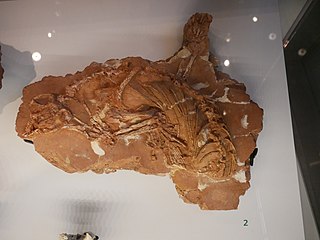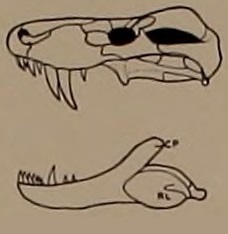
Suminia is an extinct genus of basal anomodont that lived during the Tatarian age of the late Permian, spanning approximately from 268-252 Ma. Suminia is recognized the youngest non-dicynodont anomodont. Its fossil localities are primarily derived from the Kotel’nich locality of the Kirov region in Russia. However, there have been some isolated specimen found in a few different localities, all from eastern European regions of Russia.

Dinogorgon is a genus of gorgonopsid from the Late Permian of South Africa and Tanzania. The generic name Dinogorgon is derived from Greek, meaning "terrible gorgon", while its species name rubidgei is taken from the surname of renowned Karoo paleontologist, Professor Bruce Rubidge, who has contributed to much of the research conducted on therapsids of the Karoo Basin. The type species of the genus is D. rubidgei.

Trochosaurus is an extinct genus of South African therocephalians. In 1915 and later, some of its member species were first described by Robert Broom as Trochosuchus spp. and later reassigned to the new genus. The genus includes some of the most primitive known Therocephalia.

The Tapinocephalus Assemblage Zone is a tetrapod assemblage zone or biozone which correlates to the middle Abrahamskraal Formation, Adelaide Subgroup of the Beaufort Group, a fossiliferous and geologically important geological Group of the Karoo Supergroup in South Africa. The thickest outcrops, reaching approximately 2,000 metres (6,600 ft), occur from Merweville and Leeu-Gamka in its southernmost exposures, from Sutherland through to Beaufort West where outcrops start to only be found in the south-east, north of Oudshoorn and Willowmore, reaching up to areas south of Graaff-Reinet. Its northernmost exposures occur around the towns Fraserburg and Victoria West. The Tapinocephalus Assemblage Zone is the second biozone of the Beaufort Group.

Eriphostoma is an extinct genus of gorgonopsian therapsids known from the Middle Permian of Tapinocephalus Assemblage Zone, South Africa. It has one known species, Eriphostoma microdon, and was first named by Robert Broom in 1911. It is the oldest known gorgonopsian and among the smallest and most basal members of the clade.
Elliotsmithia is a small varanopid synapsid found from the late Middle Permian of South Africa. It is the sole basal synapsid "pelycosaur" known from the supercontinent Gondwana and only two specimens have been yielded to date. Its species name longiceps is derived from Latin, meaning "long head". Both known Elliotsmithia fossils were recovered from Abrahamskraal Formation rocks—within the boundaries of the Tapinocephalus Assemblage Zone—of the lower Beaufort Group. It was named for the late Sir Grafton Elliot Smith in 1937.
Ictidognathus is an extinct genus of therocephalian therapsids that lived in South Africa during the Late Permian. Fossils are found in the Tropidostoma and Cistecephalus Assemblage Zones of the Beaufort Group in the Western Cape.

Glanosuchus is a genus of scylacosaurid therocephalian from the Late Permian of South Africa. The type species G. macrops was named by Robert Broom in 1904. Glanosuchus had a middle ear structure that was intermediate between that of early therapsids and mammals. Ridges in the nasal cavity of Glanosuchus suggest it had an at least partially endothermic metabolism similar to modern mammals.
Scymnosaurus is an extinct genus of therocephalian therapsids, first described by Robert Broom in 1903. There are three species that still take the name Scymnosaurus, S. ferox, S. watsoni and S. major, with a fourth, S. warreni, now identified as Moschorhinus warreni. Each of these have now been reclassified into Lycosuchidae incertae sedis.

Tropidostoma is a medium-sized herbivorous oudenodontid dicynodont therapsid that lived during the Late Permian (Lopingian) period in South Africa. The first Tropidostoma fossil was described by Harry Govier Seeley in 1889. Later two subspecies were identified. Tropidostoma fossils are an index fossil in a biozone of the Karoo Basin known as the Tropidostoma Assemblage Zone. This biozone is characterized by the presence of this species in association with another dicynodont species, Endothiodon uniseries.

Ulemica is an extinct genus of venyukovioid therapsids, a type of anomodont related to dicynodonts. It lived during the Middle Permian period in what is now Russia, and is known from the Isheevo assemblage of the Amanakskaya Formation. The type species, U. invisa, was originally placed in the genus Venyukovia by Russian palaeontologist Ivan Efremov in 1940. It was later given its own genus Ulemica in 1996 by Mikhaïl Ivakhnenko, who also named a second species U. efremovi. Efremov had originally intended to name the fossils of U. invisa as 'Myctosuchus invisus', however, he later recognised their similarity to Venyukovia and chose to assign the Isheevo material to this genus and leaving 'Myctosuchus' a nomen nudum.

Scylacosauridae is an extinct family of therocephalian therapsids. Scylacosaurids lived during the Permian period and were among the most basal therocephalians. The family was named by South African paleontologist Robert Broom in 1903. Scylacosaurids have long snouts and unusual saber-like canine teeth.

Venyukovioidea is an infraorder of anomodont therapsids related to dicynodonts from the Permian of Russia. They have also known as 'Venjukovioidea', as well as by the similar names 'Venyukoviamorpha' or 'Venjukoviamorpha' in literature. This in part owes to a misspelling by Russian palaeontologist Ivan Efremov in 1940 when he mistakenly spelt Venyukovia, the namesake of the group, with a 'j' instead of a 'y', which permeated through subsequent therapsid literature before the mistake was caught and corrected. The order Ulemicia has also been coined for a similar taxonomic concept in Russian scientific literature, which notably excludes Suminia and Parasuminia.
Homodontosaurus is an extinct genus of therocephalian therapsids from the Late Permian of South Africa. The type species Homodontosaurus kitchingi was named by South African paleontologist Robert Broom in 1949. Broom based his description on a small skull found in the Cistecephalus Assemblage Zone near Graaff-Reinet. The skull is very small, at about 55 millimetres (2.2 in) long and 20 millimetres (0.79 in) wide. Homodontosaurus has large eye sockets and an elongated snout. The lower jaw is long, thin, and curved. Numerous small teeth line the upper jaw and are long, pointed, and round in cross-section.
Icticephalus is an extinct genus of therocephalian therapsids from the Middle and Late Permian of South Africa. The type species Icticephalus polycynodon was named from the Tapinocephalus Assemblage Zone by South African paleontologist Robert Broom in 1915. Specimens of Icticephalus have also been described from the Cistecephalus Assemblage Zone. Broom originally placed Icticephalus in the Scaloposauridae, a group of very small therocephalians. Most scaloposaurids are now thought to be juvenile forms of other therocephalians, and Scaloposauridae is no longer recognized as a valid grouping. Icticephalus and other former scaloposaurids are now classified as basal members of Baurioidea.
Ictidodon is an extinct genus of therocephalian therapsids from the Late Permian of South Africa. The type species Ictidodon agilis was named by South African paleontologist Robert Broom in 1925. Broom classified Ictidodon in the Scaloposauridae, a group of small-bodied therocephalians that are now thought to be juvenile forms of larger therocephalians. Ictidodon and many other scaloposaurids are now classified as basal members of the clade Baurioidea.
Ictidodraco is an extinct genus of therocephalian therapsids from the Late Permian of South Africa. The type species Ictidodraco longiceps was named by South African paleontologists Robert Broom and John T. Robinson in 1948 from the Cistecephalus Assemblage Zone. Ictidodraco was once classified as a scaloposaurian in the family Silpholestidae. Scaloposauria and Silpholestidae are no longer regarded as valid groups, and Ictidodraco is now classified as a basal member of the clade Baurioidea.
Simorhinella is an extinct genus of therocephalian therapsids from the Late Permian of South Africa. It is known from a single species, Simorhinella baini, named by South African paleontologist Robert Broom in 1915. Broom named it on the basis of a single fossil collected by the British Museum of Natural History in 1878 that included the skull and jaws forward from the eye sockets. The skull is unusual in that it has an extremely short and deep snout, unlike the longer and lower snouts of most other therocephalians. Because of the skull's distinctiveness, the classification of Simorhinella within Therocephalia is uncertain. However, a 2014 study proposed that it was closely related to the basal therocephalian Lycosuchus, placing it in the family Lycosuchidae.
Parasumina is an extinct genus of anomodont known from the late Capitanian age at the end of the middle Permian period of European Russia. The type and only species is Parasuminia ivakhnenkoi. It was closely related to Suminia, another Russian anomodont, and was named for its resemblance. Little is known about Parasuminia as the only fossils are of fragmentary pieces of the skull and jaw, but the known remains suggest that its head and jaws were deeper and more robust than those of Suminia, and with shorter, stouter teeth. However, despite these differences they appear to have been similar animals with a similarly complex method of processing vegetation.
Anningia is an extinct genus in Varanopidae, a family of monitor lizard-like amniotes. It contains a single species, Anningia megalops.
















